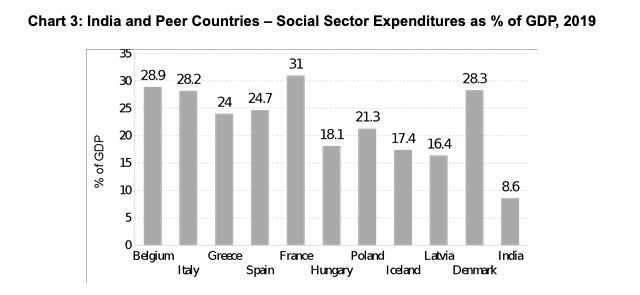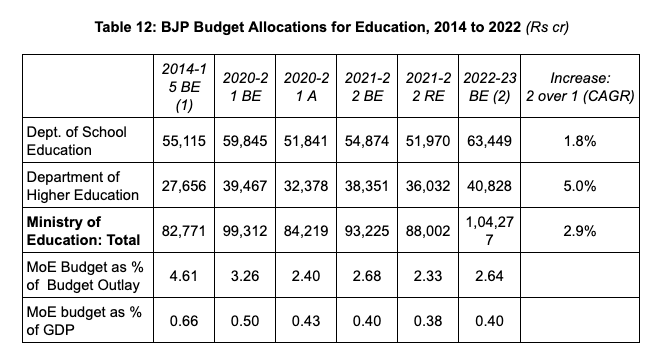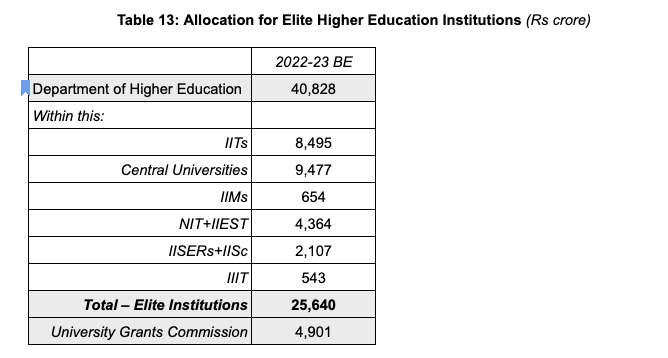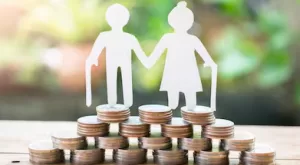Neeraj Jain
(Part III of a five part article. The previous parts have been published in earliers issues of Janata Weekly.)
Public Social Sector Expenditures: India vs Other Countries
Most developed countries have a very elaborate social security network for their citizens, including unemployment allowance, universal health coverage, free school education and free or cheap university education, old age pension, maternity benefits, disability benefits, family allowance such as child care allowance, allowances for those too poor to make a living, and much more. Governments spend substantial sums for providing these social services to their people. The average public social sector expenditures of the 34 countries of the OECD have been around 20% of GDP for the last many years, and for the EU–27 have been even higher at around 30% of GDP. In contrast, India’s social sector expenditures are just around 8.6% of GDP (see Chart 3). [1]
Since the per capita GDP of the developed countries is much more than India, so the per person social sector spending of the developed countries is many times more than that reflected by the above figures.

The major part of the social sector expenditure in India is done by the States—to the extent of 80% and probably more.[2] Which means that the total social sector spending by the Central Government is less than 2% of GDP, probably not more than 1.7% of GDP.
Let us now take a look at the budget allocations for some of the more important social sectors.
Budget and Education
Education is fundamental to human as well as societal development. Which is why in all developed countries, governments have taken the responsibility of providing Free, Equitable and Good Quality school education to All their children (the private sector invests only for profit).
Unfortunately, in India, public school education is in a terrible state. This is borne out by the extremely inadequate number of teachers in our schools. According to government data:
- more than 70 percent primary schools had three or less than three teachers; and
- 57 percent of all primary schools had three or less than three classrooms;
- implying that a single teacher is teaching two or three different classes at the same time in a single room in a majority of the primary schools in the country! (The situation is equally bad in the senior-level schools in the country.)[3]
At the same time, because of low level of government spending, a majority of our schools lack even basic infrastructure like electricity and computers.[4]
Therefore, it is not surprising that the quality of education in our schools is so bad that nearly half the children in Class 5 are not able to read Class II–level text, and nearly three-fourths (72 percent) cannot solve a simple division problem.[5]
It is because of our government’s unconcern for educating our children that the 2011 Census figures, the most reliable data source in the country, show that of the 20.8 crore children between the age of 6–13 in the country, 3.2 crore or 15.4 percent children have never attended any school![6] That is huge.
And of those who enrol in school in Class I, a large number don’t even complete elementary school. The drop-out rates at the various levels are:[7]
- Drop-out rate at the primary level is 15.5 percent;
- Drop-out rate at the elementary level is 30 percent (this means that of 100 children enrolled in Class 1, only 70 reach Class 8).
- Drop-out rate at the secondary level is a huge 47.3 percent.
Reason for this terrible situation is, that government expenditure on school education is very low.
The BJP, led by Narendra Modi, promised to rectify this situation and increase spending on education to 6% of GDP on education—as recommended by the Kothari Commission on Education several decades ago. This too, like all its other election promises, has turned out to be a jumla. The Economic Survey 2021–22 admits that total education spending of the government (Centre + States) continues to languish at a mere 3.1% (2021–22 BE).
This same trend has continued this year too. While on paper, the total budget for education (school +higher education combined) has gone up by 12% as compared to last year’s budget estimates, the total increase in the education budget over the 9 budgets presented by the Modi Government so far is just 5.3%, which means a cut in real terms. As a percentage of budget outlay, the Centre’s education budget has fallen to just 2.64%, from 4.14% in 2014–15A, that is, it has nearly halved.
School Education: Betrayal of Our Children
In this year’s BE, the school education budget has been increased by 15.6% over last year’s BE. For the last several years, the actual spending on education has been much less than the budgeted estimate, so in all probability this increase is only window-dressing.
Even if take the budgeted estimate at face value, during the nine budgets presented by the Modi Government so far, the increase in the school education budget is only 1.8% (2022–23 BE compared with 2014–15 BE)—which implies a huge reduction in real terms, by as much 38% (CAGR, assuming inflation of 8% per year).

Further, of the total school education budget, nearly 20% is on just Kendriya Vidyalayas and Navodaya Vidyalayas. The total number of these schools is less than 2000. These are the elite among the government funded schools, with a full complement of teachers and good infrastructure. This year too, their budget has been increased by more than 10%. For the remaining lakhs of government and government aided schools, the government has gradually been cutting their budgetary allocation to very low levels.
The dismal state of our schools and the fact that the government is further cutting its budgetary allocation for them can mean only one thing—that the Modi Government is simply NOT INTERESTED in educating all children. It also means—that the government wants to privatise school education. The strategy adopted for this is simple: ruin the quality of government school system by cutting the funding of school education and keeping teaching posts vacant; children will automatically exit government schools, and those who can afford it will join private schools. The consequence: more than 2 lakh government schools have closed down till date.[8] This figure was for 2018. Many many more schools must have shut down since.
Every year, to cover up for this low level of budgetary spending on school education, the Finance Minister dishes out some jumlas in the budgetary speech. This year, she stated that the government recognises the need to support children from the marginalised communities who have suffered due to the pandemic induced closure of schools, and for this announced: “For this purpose, ‘one class-one TV channel’ programme of PM eVIDYA will be expanded from 12 to 200 TV channels. This will enable all states to provide supplementary education in regional languages for classes 1–12. In vocational courses, to promote crucial critical thinking skills, to give space for creativity, 750 virtual labs in science and mathematics, and 75 skilling e-labs for simulated learning environment, will be set-up in 2022–23.”
The ‘Godi Media’ immediately hailed this initiative. But what no one mentioned was that there only a very few schools are in any position to take advantage of the various schemes being announced as a part of promoting digital learning. Official data tell us that barely 80% of schools have functional electricity, only 37% of schools in the country have a functional computer facility, and only 22% schools have an internet connection. For government schools, the situation is even worse: only 29% of schools have functional computer facilities, and 12% of schools have internet available. (9)
The FM is very aware of this. So, she has announced no budgetary allocation for this in the school education budget. The allocation for PM e-vidya has been made in the higher education budget, and there too, the budget for this has been reduced from an already laughable Rs 50 crore in last year’s BE to Rs 1 lakh in last year’s RE and Rs 1 lakh in this year’s BE too! The total budget for what is called Digital India e-learning in the higher education budget has been slashed from an already low Rs 646 crore in last year’s BE to Rs 368 crore in last year’s RE and Rs 421 crore in this year’s BE.
Even if the government had increased the budget for digital learning to decent levels, it really wouldn’t have helped our children as students learn best from teachers, not from online classes on mobile phones and TV screens. So what is important is that government increase allocation for improving our schools and appointing more teachers—and there are no indications that it is interested in doing that.
Covid and School Education
This brings us to the most important crisis facing school education in our country. And that is—that 15 lakh schools remained closed for nearly two years during the pandemic, affecting 28 crore children from pre-primary to secondary levels. They are now beginning to reopen. The overwhelming majority of children in India, around 77% according to a parliamentary standing committee, could not attend online classes as they did not have access to a device.[10] Many of those who did have access to a device would not have been able to attend classes at home due to pressure to do household chores, being forced to work, a poor environment for learning and lack of support in using the online curriculum. Now, with schools reopening and children coming back to school, all those who could not access online education would have suffered a huge learning loss, and special efforts need to be made to enable them to recover their lost education. Otherwise, they are eventually going to drop out.
Both the Economic Survey as well as the Finance Minister’s Budget speech recognise that children have suffered due to closure of schools due to the pandemic. But amazingly, the FM sees no need for any remedial action, such as pushing state governments to promote supplementary education for all such affected children, and making a special allocation for this in the school education budget. The Samagra Shiksha Abhiyan (SMSA) is the key centrally sponsored scheme for school education. For the year 2021–22, the revised estimates for this are actually lower than the budgeted amount; this year, while the budget allocation for this has been increased, it continues to remain lower than the BE for 2020–21.
While the Modi Government claims to champion ‘Beti Bachao Beti Padhao’, the Centre has completed ended budgetary allocation for National Scheme for Incentive to Girl Child for Secondary Education in this year’s budget. It has also reduced the allocation for the Pre-Matric Scholarship for Scheduled Castes and others and the Scholarship for Disabled Students. These expenditures should have been prioritised considering the disproportionate impact of the pandemic on girls and children from marginalised groups. Studies such as by Harvard Political Review have pointed out that Covid-19 has adversely impacted young girls and might cause 10 million girls to drop out of secondary schools.[11]
Clearly, the Modi Government is not interested in educating our children—it prefers to educate them through the ‘whatsapp university’ run by the BJP propaganda department.
The Business of Higher Education
Privatisation of higher education has taken place at a much faster pace than that of school education, because of which more than two-thirds of all higher education institutions in the country are today in the private sector.[12] Private higher educational institutions are all for-profit institutions; therefore, very few students can afford their fees. With the result that barely 20% of children in age group 17–23 are in any kind of higher education degree or diploma course; this proportion is above 60 for developed countries; for many countries, this ratio is above 70.[13]
During the Modi years, privatisation and commercialisation of higher education has accelerated. During the nine Modi budgets presented so far, the Centre’s spending on higher education has increased by just 5% (CAGR), and considering inflation, it implies a cut in real terms. Because of this, most government funded colleges are starved of funds and so, to meet their expenses, are being forced to increase student fees using all kinds of excuses. Consequently, studying in government funded educational institutions too is becoming unaffordable for students from poor families.
Even within the limited higher education budget, most of the funding is going to elite government institutions like the IITs and IIMS:
- Allocation for the University Grants Commission, that regulates the higher educational institutions in the country and provides grants to more than 10,000 institutions, has been halved in the nine Modi budgets, from Rs 8,978 crore in 2014–15 BE to just Rs 4,901 crore in 2022–23 BE.
- Likewise, allocation for the All India Council for Technical Education, the regulator of engineering education in India, has remained dismally low during all the 9 Modi budgets and is a lowly Rs 420 crore in the 2022–23 BE.
- The Rashtriya Uchhatar Shiksha Abhiyan is the most important Centrally Sponsored Scheme for providing aid to state higher and technical institutions to improve their quality, equity, access, and research. However, the budgetary allocation for this has been sharply reduced. It was allocated Rs 3,000 crore last year; the revised estimate show that spending has come down to just Rs 793 crore; and this year’s allocation is Rs 2,043 crore, one-third less than last year’s allocation. The government is clearly not concerned about improving the overall quality of our higher educational institutions.
- In contrast, more than 50% of the higher education budget has been allocated for the elite higher educational institutions, that is, the IITs, IIMs, IISERs, NITs, IIITs, IISc, and the Central Universities. The total allocation for them is Rs 25,640 crore, which amounts to 63% of the total higher education budget!

Teachers’ Training
There are several problems with the Modi Government’s New Education Policy. But one positive was its emphasis on teachers’ training and research. But the budget for teacher training and adult education in the school education budget has been halved (from Rs 250 crore to Rs 127 crore) from last year’s budget estimate (while the revised estimate shows that the government spent practically nothing on this last year). Likewise, there are several schemes in the higher education budget under the head Research and Innovation, but the total funding for all these schemes was a tiny Rs 237 crore in last year’s BE, and even this has been cut to Rs 219 crore in this year’s BE.
This is actually not surprising. If the government is not keen on educating our children, why would it spend money on improving the quality of our teachers!
Cogs in the Corporate Wheel
The corporate-fascist alliance ruling the country is very clear in its outlook. There is no need to educate the young, especially those from the marginalised sections—only then can they be transformed into mindless automatons in the service of virulent Hindutva. So the overall budget for government colleges where the children of the poor study has been sharply reduced in the eight years of Modi rule.
But the corporates also need good quality engineers and managers. And so, despite this cut in allocation for education, the spending on elite schools and engineering / management colleges and setting up so-called ‘world class institutions’ is being increased, and constitutes nearly two-thirds of the higher education budget. Private higher educational institutions are also proliferating—which cater exclusively to the children of the rich.
At the same time, the corporates also need skilled workers for their assembly lines. For this, the youth must be trained—not educated—so that they can become cogs in the corporate wheel. For this, the Modi regime has opened a separate ministry, the Ministry of Skill Development, and allocation for the most important program under this, the Pradhan Mantri Kaushal Vikas Yojana, has more than tripled since it was launched seven years ago.

Notes
1. Source for OECD: “Social Spending”, https://data.oecd.org; for EU: Government Expenditure on Social Protection, https://ec.europa.eu; for India: Economic Survey, 2021–22. EU–27 figure includes general government expenditure on education, health and social protection (this includes sickness and disability, unemployment, old age, housing, etc). Within this figure, EU–27 public expenditure on health and education was 11.6% of GDP; India’s public expenditure on health and education (both Centre and states combined) totalled 5.2% of GDP. India’s figures are much inflated as the government has included expenditure on Sports, Arts and Culture in the expenditure on Education, and expenditure on Water and Sanitation in expenditure on Health.
2. “Resource Sharing between Centre and States and Allocation across States: Some Issues in Balancing Equity and Efficiency”, Institute of Economic Growth, July 2019, https://fincomindia.nic.in.
3. Calculated by us from data given in: Elementary Education in Urban India, Analytical Report, 2015–16 and Elementary Education in Rural India, Analytical Report, 2015–16, NUEPA, New Delhi.
4. See the statistics given in: School Education in India, 2015–16, Flash Statistics, U-DISE 2015–16, NUEPA, New Delhi, 2016, http://www.dise.in.
5. Tish Sanghera, “Fewer Children Out of School, But Basic Skills Stay Out of Reach: New Study”, 16 January 2019, https://www.bloombergquint.com.
6. India’s Missing Millions of Out of School Children: A Case of Reality Not Living Up to Estimation?‛ 2 November 2015, https://www.oxfamindia.org.
7. Calculations done by us, based on data given in: School Education in India, 2015–16, Flash Statistics, op. cit. We have taken the annual drop-out data for primary level, and used it to calculate the overall drop-out rate for primary education. Then, we have used the Transition Rate data and annual drop-out rate for upper primary level, to calculate the overall elementary level drop-out rate.
8. Ambarish Rai, “Budget Focus on Infrastructure, Digital Education Cannot Work in a Vacuum”, February 2, 2018, https://thewire.in.
9. UDISE data for 2019–20: “Only 39% schools in India had computers, 22% had internet connection in 2019–20”, 2 July 2021, https://www.thenewsminute.com.
10. Protiva Kundu, Revati Patil, “Does the Union Budget 2022–23 Offer Inclusive Recovery for School Education?” 8 Feb 2022, https://www.newsclick.in; Kaushik Deka, Shelly Anand, “Covid-19 Fallout: The Impact on Education in India”, 3 January 2021, https://www.indiatoday.in.
11. Nivedita Sarkar, Anuneeta Mitra, “Education Budget: Going Nowhere on a Digital Train”, 20 February 2022, https://www.newsclick.in.
12. “Majority of Indian Colleges are Run by Private Sector, Govt Tells Rajya Sabha”, 29 July 2021, https://www.livemint.com; see also: Neoliberal Fascist Attack on Education, pp. 51–52, Lokayat publication, available on Lokayat website, http://lokayat.org.in.
13. J.B.G. Tilak, How Inclusive Is Higher Education in India? 2015, http://www.educationforallinindia.com; see also: Neoliberal Fascist Attack on Education, Lokayat publication, ibid.
(Neeraj Jain is an activist with Lokayat, Pune and associate editor of Janata Weekly.)




